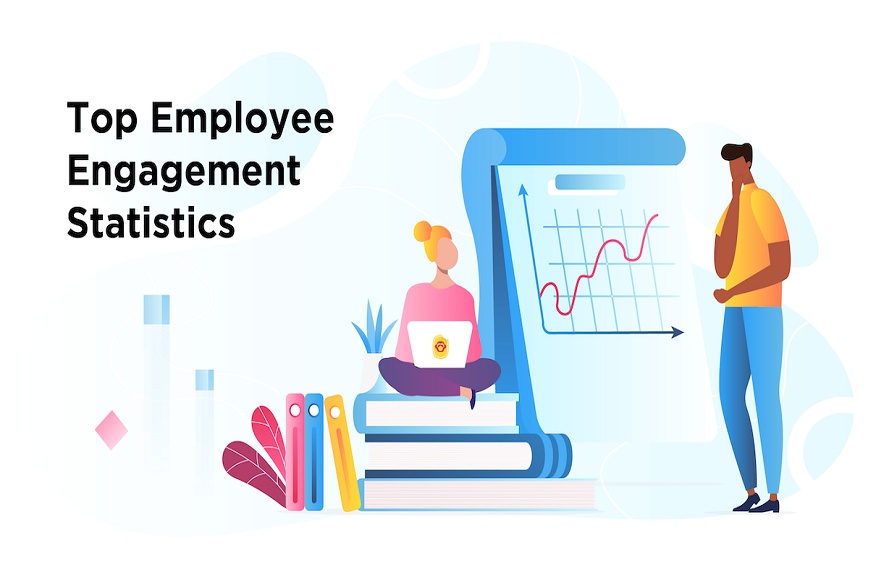How can HRMS help in improving employee engagement rates?
Employee engagement is one of the most critical business issues that affect growth and retention. When employees are involved in their work environment, they are more likely to stay with the company. To get employees more involved, businesses need sophisticated solutions, strategies, and tools.

Employee engagement is defined as having a clear understanding of how an organisation carries out its mission, core values, and goals, as well as how it is changing to reach those goals better, and having a chance to share ideas and opinions that are taken into account when decisions are made.
5 Ways For HRMS To Improve Employee Engagement For An Organisation:
1. Social networking for businesses
Having an effective internal communication system in place could make employees more interested in their jobs. It is essential to emphasise listening consistently. The ideas and thoughts of employees are important, and listening to them can help the company in many ways.
Enterprise social networking is about integrating people, processes, and back-end systems in a way that makes sense. If your employees only use a system to create activity streams, it is not an enterprise social network.
Upper management must make sure that corporate social networking is all about summarising data from back-end enterprise systems and presenting it in a way that gets employees’ attention and encourages them to interact with it.
An internal HRMS software platform embedded with a social intranet makes it easy for employees to talk about work-related things. This will make it easier for all employees in the organisation to communicate with each other without any problems.
An enterprise social networking system can help employees connect and come up with good ideas and boost their morale. It can also help employees from different departments, and roles get to know each other and work together.
2. System for managing performance
One significant change that an HRMS could help with is giving feedback on performance more often. Instead of saving information for that annual review, managers can use a continuous recording of performance-related data to provide real-time feedback to employees – whenever it’s needed.
The more unique the feedback tools, the more likely the person will find the feedback useful and actionable, which will improve performance.
An HRMS employee database with built-in performance management gives a history of each employee’s performance throughout their employment. This gives a bigger picture and makes it possible to look at trends, patterns, and one-time blips.
Every so often, employees and their bosses get together to talk about how well the employees are doing their jobs and how to boost morale.
Mentoring and coaching are also good ways to give performance management feedback to employees to help them do their jobs better and get them more involved in their work. With the help of the best gamified HR software, you can get your employees to work harder.
3. Reimbursement management
Employee cost reimbursement software has brought about a new era of ease. We live in a world where real-time reporting and approvals make sure that payments and reimbursements are made correctly and on time. Employees no longer have to keep copies of every receipt they get and type the information into a direct report by hand.
Employees often use their own money to do work for the organisation. Employees can lose motivation and be unhappy if they have to go through a lot of paperwork to get their money back.
Few employees take the time or make an effort to learn about the cost procedures that are in place to help them manage and control their business-related purchases. With employee expense reimbursement software, you can make flexible policies because you can change the rules, set spending limits, and define approval processes.
The reimbursement process should be smooth, easy, and quick so that employees don’t have to go through a complicated and time-consuming process to get the money they spent on organisation-related things reimbursed.
4. Payroll that works well
Payroll is often one of the things that HRMS software in India does these days. From a data point of view, it all makes sense. Time and attendance, staff scheduling, and managing absences are all standard HRMS features that can be used to figure out payroll.
With an HRMS payroll, there are fewer mistakes because everything works together. Because of this, it takes less time for employees to fix these kinds of errors.
The way a company pays its employees should be fair, timely, and in line with industry standards. Money is a big motivator and driver of employee satisfaction because it helps them feel like they are getting enough money at the right time. This makes them even more likely to do their best at work.
Timesheet systems that track employees’ attendance or work time can be linked to payroll. This makes it easier to figure out pay because the payroll system automatically sends information about hours worked.
As the main driver, incentives, pay, and benefits have a significant impact on and shape employee behaviour at work. They can also increase engagement levels by a lot.
5. Shift planning
To get the most work done at the office, employees’ work hours should be regulated in an effective way. Employees should be given shifts that are convenient and fit their needs.
HRMS is an excellent tool for planning work shifts, which lets HR professionals make intelligent choices about staffing needs, extra time, on-call hours, work expenses, and more. The open HRMS employee shift management can help manage employees’ work schedules by making sure they are set up well.
Shift policies should be the same for everyone, and everyone should get a week off every week to rest and relax. Telecommuting and working from home are good options for remote workers with family responsibilities, and they will help workers feel more connected to their work.
Wrapping up
Engaging employees is different from making them happy. CEOs often talk about “employee happiness” surveys, but the bar isn’t high enough. A happy worker might not complain about her 9-to-5 job, but they might not go the extra mile to help the company grow as a whole.
Employees who care about their work and the culture of the company are emotionally invested in both. They don’t work for a paycheck or the next promotion. Instead, they try to reach the organisation’s goals and work towards goal progress.






















